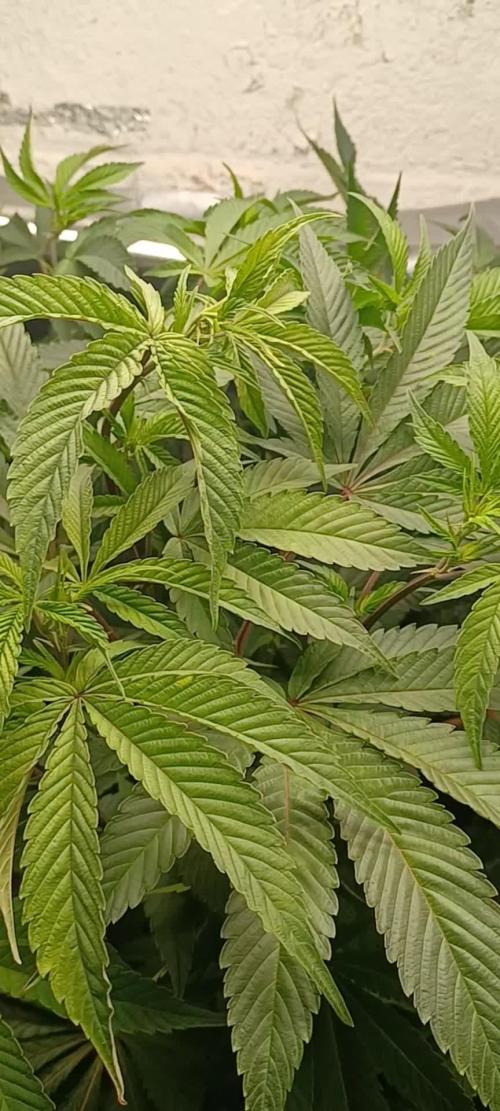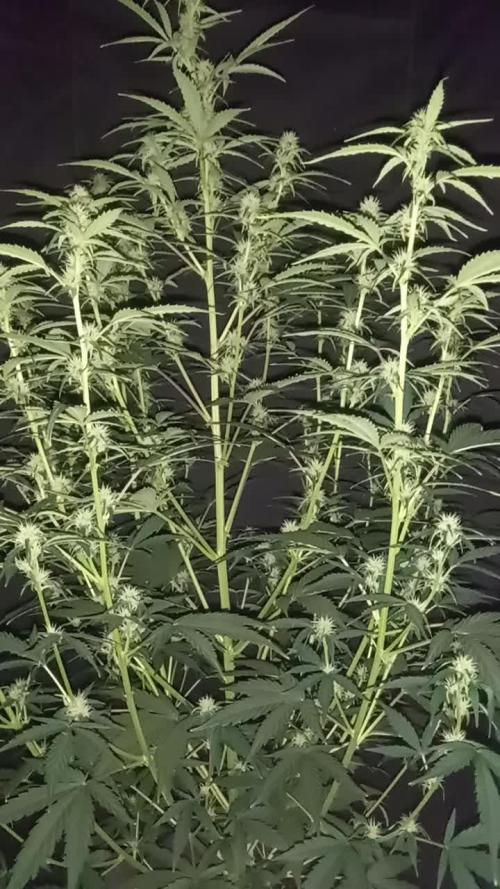The Grow Awards 2026 🏆 



























Likes
8
Share


@Rko41
Follow
Belle odeur les feuilles pointent vers le bas normal faut que je l’arrose ;-)
Likes
31
Share


@microgrowshow
Follow
Overall this was a fun grow! It was supposed to be a mini SOG with other 1 gallon autos, but they didn't make it unfortunately, so had to make the best of it! Happy I kept going cause I was extremely happy go grow such a beautiful pheno. By far the deepest purple colours I've ever seen on any plant. Just hope I'll see it again :) .. anyway, not a bad yield for a one gallon grow! 60 grams of bud and another 18 of larf and shake. Time to cure and enjoy 😎
Likes
31
Share


@Canna96
Follow
Hey now, hope everyone is having a great weekend! The Strawberry Banana Auto from Fastbuds is starting to smell very good and starting to stack up nicely. She is only 26 inches tall but I feel like her colas are going to be quite thick. I did a light defoliation this morning and took off all the LST tie downs. She is looking super healthy and loving this Medic Grow Spectrum X.
I currently have the Spectrum X running at 100% power and also integrating the UV/IR bars for 75 minutes just prior to lights off. I am super happy with this light so far, she puts out impressive PAR, and runs fairly cool. The only thing I would change is to add a timer just for the UV/IR bars, and allow the main light to be run on a timer.
I will probably do one last light defoliation in the next couple of days and that will be about it other than keeping the reservoir full and in the correct PH range. The tomatoes outside are absolutely loving the runoff from these autos, as that is all they have had to drink since they were about 3 weeks old.
Thanks for stopping by, Stay Safe and Blaze On!!! 💪
Website: https://medicgrow.com/
https://growdiaries.com/grower/medicgrowled
Likes
12
Share


@Roberts
Follow
Fast version A is doing good. She is waiting on the flowering room to open. Lots of training to come. Thank you Dutch Passion, SSSC, Athena, and Medic Grow 🤜🏻🤛🏻🌱🌱🌱
Thank you grow diaries community for the 👇likes👇, follows, comments, and subscriptions on my YouTube channel👇.
❄️🌱🍻 Happy Growing 🌱🌱🌱
https://youtube.com/channel/UCAhN7yRzWLpcaRHhMIQ7X4g.
Likes
9
Share


@Chubbs
Follow
Weekly update on these couple. One got the chop for some fresh frozen bubble wash and these two still have another week for the one and only a couple days for the other. They smell like a bakery and are covered in frost. All in in an easy one to grow and produces amazing flowers and yields.
Likes
7
Share


@Fiyagrowa
Follow
12/8 Pushing her into ripening. She has recovered nicely and she's coasting for the next few weeks until harvest. Im taking her one week earlier as I want her a little bit earlier in her window.
12/10 Just checking in and showing off some of her tricromes.
Likes
32
Share


@Ganjagrandaddy
Follow
Day 35 Flowering: Hi Growmies, hope we are all well and in the green.
The Exotic ladies have been displaying their skills this week and fan dancing to this beautiful set of buds now filling the spaces. The smell from them is definitely identified as mango now too.
#1 is fattening out her buds all the way to below the canopy tops too. She isnt the biggest in height but is pushing out some very nice thick buds sets
#2 is the biggest of the 4 Mango cream with a chunky nice looking mainstem that I tried to avoid forming. She had other ideas I think. The side growth is just as impressive too with fat colas forming nicely
#3 is the odd one of the bunch. She is between the two lights and lifted higher than the other 2 the same age but smaller in general. she looks way more mature than the other plants too which is odd. Her colours are really showing through like finished buds tend to look pre chop. She smells so strong of mango too. still with at least 4 weeks to go it will be interesting to see how she matures further..
#4 is at day 28 flowering and has pellets as her feednin the medium. She looks a little rough and nowhere near as healthy as her sisters do. signs of mg deficiency are heavy too and I am using the bloom element that is with the pellets now too. I thinknthe pellets have finished being of use now and might have to get her in mx after all. Her buds look OK but need some powering now from the greenery stores.
All in all things are going well with these ladies and I can only imagine how good they will harvest now.
Be safe growmies
***UPDATE DAY 39 MAJOR DEVELOPMENT***
A major development in the ripening of one of the mango cream girls.
#3 has reached full maturity!!!! I thought she was developing very nice colours and a texture similar to harvested wedding cake strains I have done. as she was still really early in flower and in a small pot , I assumed it was something to do with this that had accelerated her a little in some way. Seeing her trichromes under the scope and seeing amber ones today has me convinced she is done already at 39 days in flower only. Wow thats a fast flowering for a plant of this size too. I have not seen any do this before except a barneys farm Blue gelato that hermied at week 3 flower with perfect seed pods and very mature flowers lowndown . i am leaving her a few days more to see exactly what she does but will keep you posted. Happy days.
Likes
14
Share


@Bushleague_Botanicals
Follow
So… 12 cuttings, 2 are toast right off the bat. 3 have rooted, 1 of which was transplanted into 3 gal pot and the two 8 day clones will stay another day in the humidity dome in veg tent (now known as Planck). My flowering tent is called Einstein (don’t judge me!) 😂 I have the vs1000 at 25% in Veg tent and sf4000 at 100% in flowering tent.
I decided that I want feminized seeds from one (2) of these ladies so I’m going to pick two clones, one to get hit with colloidal silver to make pollen sacks and the other to get pollinated. Since both clones are female they don’t have the Y chromosome so they can’t make male seeds (although you could have a herm I guess and not know it. Maybe? Dunno) When the colloidal silver disrupts the plants normal flowering process it makes the plant make pollen sacks but doesn’t change the DNA of the plant so you are only getting XX from the pollen. And the recipient plant is also XX so the resulting seeds are only female. If I’m wrong please correct me…anyone!! What if I pick two clones from same mother?! Hmmmm. Also got to be careful to not pollinate the 7 in the flowering tent (Einstein). Plastic bags over the plant? Separate tent enough? We will see…
I’m naming the clones that root after famous female scientists I admire.
The first one is Ada, after Ada Lovelace, who was an English mathematician and writer, chiefly known for her work on Charles Babbage's proposed mechanical general-purpose computer, the Analytical Engine. (https://en.wikipedia.org/wiki/Ada_Lovelace)
The other two get named when they are transplanted.
For the 7 in the flowering tent it’s just hurry up and wait. Right?
Processing
Likes
4
Share


@Skillgrower
Follow
Deviam estar maiores os brotos para o tempo que tem se floração, mas por causa de stress a mais e eu ter estado ausente atrasou bastante.. mas nada q o revive da advanced nutrients nao resolva cm tempo nada esta perdido..
Foi dia de lolipoing nas mais desenvolvidas mais uns dias e faço na mais pequena tambem
Likes
1
Share


@StaresAtPlants
Follow
Trying to dial their veg in. Nutes may be too old or too high. Changed with 4ml CaMg per gallon of RO water. The rest is MaxiGrow.
Ever since adding rockwool to the grow, I have struggled. I don't have the dry back timed right yet. I moved my fan to dry the top of the pot surface instead of in the root zone or at the canopy height. After about 10 days I dumped out the rockwool and have replaced with hydroton.
My initial though on using rockwool was to give the roots more space during late life stages. My experience has been with hydroton and I notice that the roots eventually get bound because the hydroton is a durable material and will not crush or compact. Rockwool on the other hand will compress when squeezed so I was hoping that in the late life stages the roots would compress the rockwool and make more room in the pots. The issue was dryback. If I used chunks instead of croutons, this may help but the other reason I used them was because I had them here already. If anyone is trying to slow their dryback down, they should consider adding 10% volume of croutons to hold moisture in the medium a bit longer. Notice anything different?
They are starting to adapt to their new media. Hopefully by next week I can get them to perk up.
One plant has looked better than the other three. I have no idea what these plants need to “perk up”. Possibly a different grower. If a grape terpine wasn’t in the end results I would have culled these long ago. Hopefully they perk up when we get to flower.
3 look ,,,, meh, the fourth is descent. Trimmed all four back down to 12” tall. Flower next week.
Likes
Comments
Share


@SignalAndSoil
Follow
At one point, the water in the reservoir became anaerobic, causing the plants stress, so I cleaned it out along with the tray and reapplied the BioBizz nutrients according to the chart. I also added an aquarium pump to help keep the water stirred. When using organic nutrients, I realized that the pipes can become clogged, so every four weeks, I flush and clean everything. Other than that, and some temperature heat waves that I struggled with, the plants were happy.
Likes
23
Share


@adam_pawloski87
Follow
This week has been great ,today is day 78 and the girls are just doin their thang , 1 looks ready for flush already and the rest look about another longer then flush for them aswell,, can’t wait to see how these girls finish out over the next couple of weeks 😍!! Y’all keep them eyes peeled an stay tuned for next week! Peace love an positive vibes to y’all Cheers.💨💨💨
Likes
5
Share


@GaizkaDinafem
Follow
This week I´va started to smell some sweet and fruity aromas... 😊😊😊 The buds are taking weight and the trichomes start shining 🙌
Likes
147
Share


@Zurban_Poison
Follow
Hello all friends!
Last week I disturbed my girls for the last time. did a very hard defoliation. also cleared of everything superfluous that was below the skrog.
Overall, both plants are doing great.
I think that the harvest should be excellent and high quality! Now all that's left is to wait!!
@Zammi_official what can you say abouth this Double Gorillas?😜



























